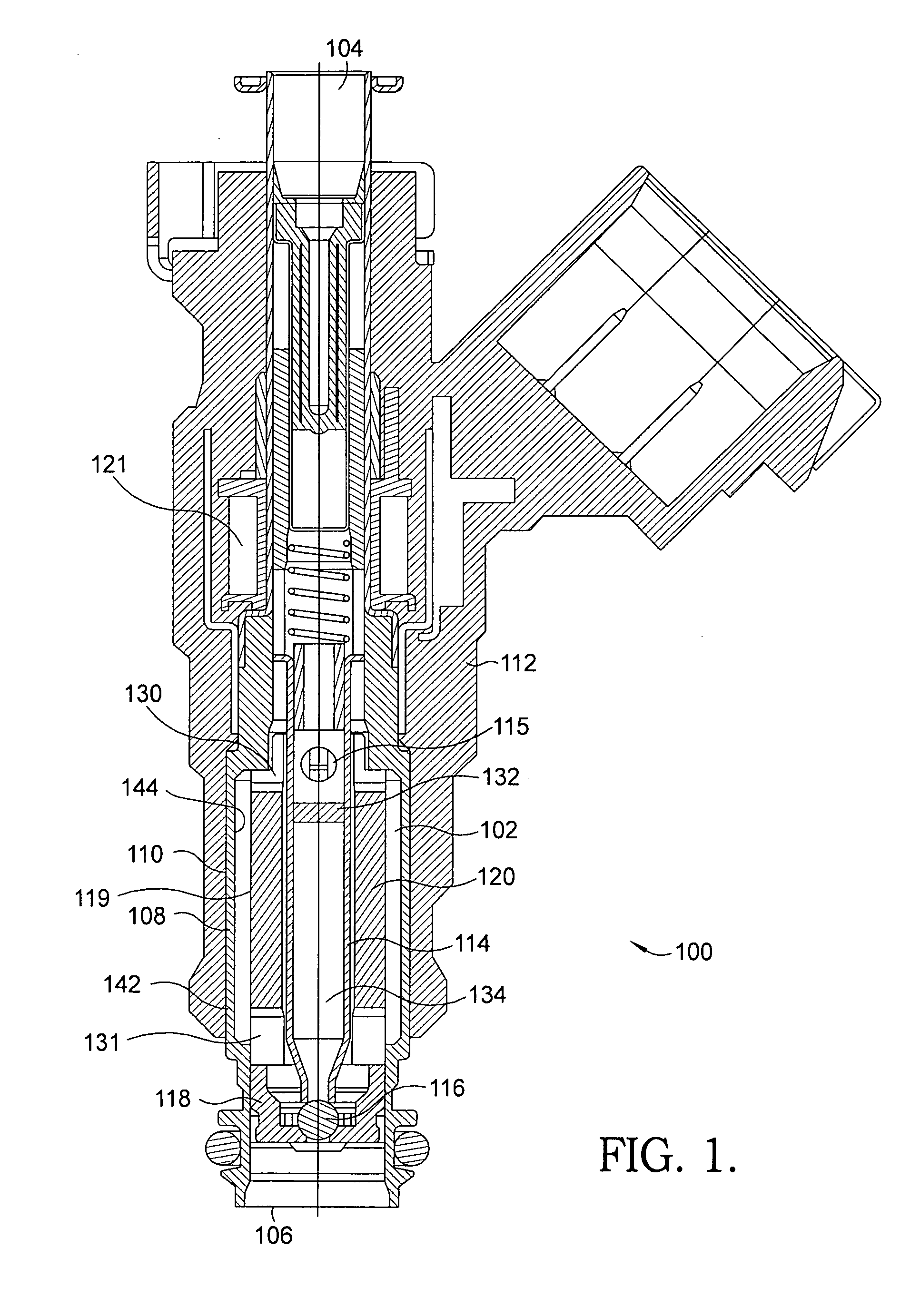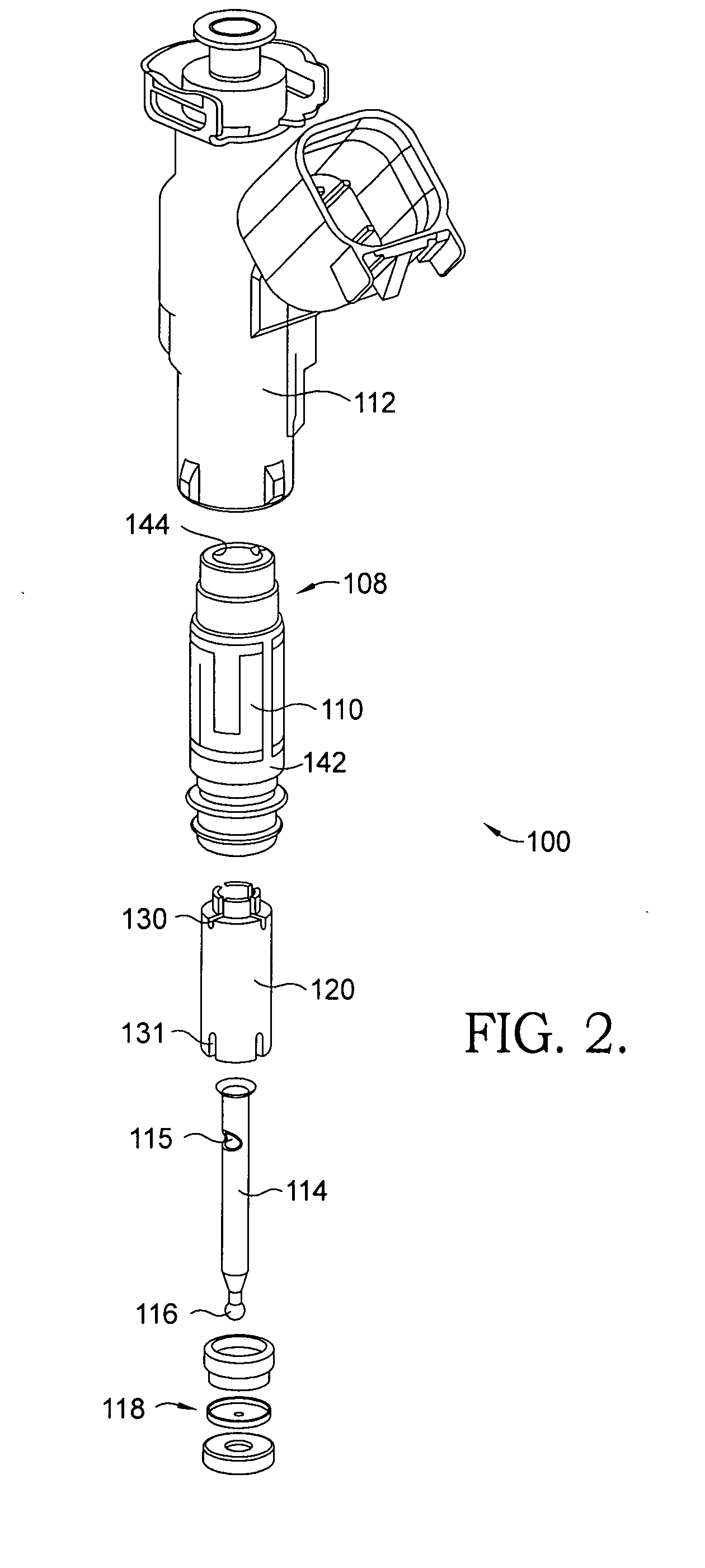Heated fuel injector
a fuel injector and heated technology, applied in the direction of fuel injectors, machines/engines, mechanical equipment, etc., can solve the problems of increasing the problem of fuel/air charge, difficulty or inability to start spark-ignited engines fueled by ethanol, and increasing the difficulty or inability to start spark-ignited engines. , to achieve the effect of increasing the thermal efficiency of the heated fuel injector, increasing the available contact surface area, and large surface area
- Summary
- Abstract
- Description
- Claims
- Application Information
AI Technical Summary
Benefits of technology
Problems solved by technology
Method used
Image
Examples
first embodiment
[0035]Referring to FIGS. 1 and 2, a fuel injector 100 includes a spacer 120 having a low thermal conductivity, assembled within a body 108 of injector 100 in accordance with the invention. Injector 100 may be a fuel injector for port injection as illustrated or a fuel injector for direct injection of fuel. The fuel flowing through fuel injector 100 from a fuel inlet 104 to a fuel outlet 106 may be any type of liquid fuel, for example, an ethanol based fuel, gasoline, or diesel.
[0036]Body 108 of fuel injector 100 has a heater element 110 applied to an outside surface 142 of the body for transferring heat to the body by the heater element. Heater element 110 may be, for example, a thick film heater printed on the outside surface 142 of body 108. An overmold 112 or other type of protection covers body 108 and heater element 110. Fuel passage 102 is defined by an inside surface 144 of body 108 and an outside surface 119 of spacer 120. A valve assembly includes pintle shaft 114 and a val...
second embodiment
[0041]Referring to FIGS. 4 (A and B) through 6 (A and B), exemplary fuel injectors 200, 300 and 400, and fuel injector bodies 208, 308 and 408, including features such as single threads 246, multiple helical threads 346 and an array of projecting pins 546 are shown. These features provide an increased heated surface area coming in contact with fuel in accordance with the invention. By increasing the inner surface area of the heated injector body, the efficiency of heat transfer from the heated body to a fuel having a low heat diffusivity, such as ethanol based fuels, may be increased.
[0042]Referring to FIGS. 4A and 4B, a fuel injector 200 including a body 208 having an outside surface 142 and an inside surface 244 is shown. (Note: features identical with those in fuel injector 100 carry the same numbers; features analogous but not identical carry the same numbers but in the 200 series.) A single groove formed as a helical channel 246 is included on inside surface 244 of body 208. He...
third embodiment
[0048]Referring to FIGS. 7 through 11, spacers 620, 720, and 820 are assembled within a heated body of a fuel injector, such as body 608 of fuel injector 600 as shown in FIG. 8 in accordance with the invention. Thermally conductive spacers 620, 720, and 820 are in direct thermal contact with the heated body (see, for example, contact points 749 of feature 748 with body 708 in FIG. 9), and are utilized as heat exchangers conducting heat to the fuel as well. By adapting thermally conductive spacers 620, 720, and 820 to be in direct thermal contact with the heated body, the available surface area for heat transfer to the fuel can be substantially increased and heat energy can be redirected to otherwise unheated portions of the flow field of the fuel injector. As a result, the thermal efficiency of the heated fuel injector can be improved.
[0049]Spacers 620, 720, and 820 may be formed of a material different from the material of the heated body. This allows greater latitude for selecting...
PUM
 Login to View More
Login to View More Abstract
Description
Claims
Application Information
 Login to View More
Login to View More - R&D
- Intellectual Property
- Life Sciences
- Materials
- Tech Scout
- Unparalleled Data Quality
- Higher Quality Content
- 60% Fewer Hallucinations
Browse by: Latest US Patents, China's latest patents, Technical Efficacy Thesaurus, Application Domain, Technology Topic, Popular Technical Reports.
© 2025 PatSnap. All rights reserved.Legal|Privacy policy|Modern Slavery Act Transparency Statement|Sitemap|About US| Contact US: help@patsnap.com



